Warszawa II (14 page)
Authors: Norbert Bacyk

A battery of “Hummel” tracked artillery from the SS-Panzer-Artillery-Regiment 5 “Wiking” in combat, Poland, summer of 1944. (CAW)
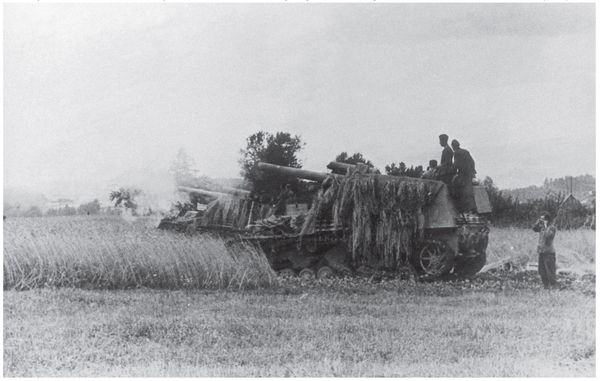
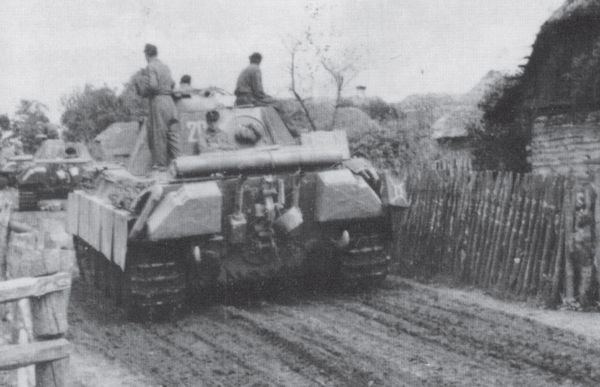
Three Panthers drive through a village on their way to the front. Air superiority has probably been established or, alternatively, the crew feels over-confident, given their relaxed posture on the deck of the last tank. The vehicles hail from the 2nd SS-Panzer-Regiment 3 “Totenkpf”. The location is east of Praga, August 1944. (Leandoer & Ekholm Archive)
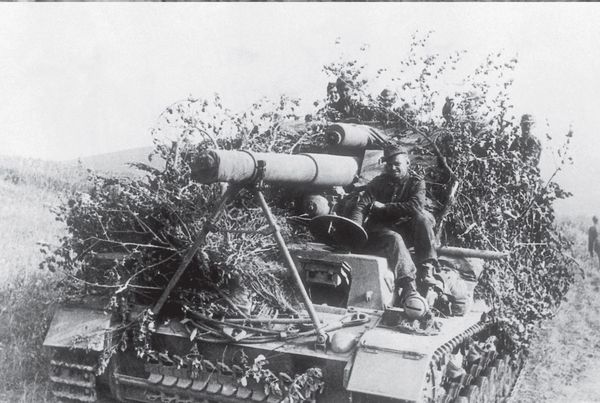
A tracked artillery gun, 15 cm sFH 18/1 Fgst auf Gschw III/IV “Hummel” from an unknown unit, Eastern Front, Summer 1944. (CAW).
August 7 â September 9, 1944
T
o a great extent, the development of combat operations outside Warsaw depended on Stalin's wishes. No later than August 2, he received verified intelligence from Poland's capital that reported the Uprising had begun. On August 3, this event was directly confirmed by Polish Prime Minister StanisÅaw MikoÅajczyk who had flown to Moscow from London for talks concerning the future of his country. There was no doubt about it being the Home Army that stood behind the Uprising, and there was equally little doubt about the in-country representatives of the Polish Government having swung into action.
Simultaneous with these political developments, on August 2, or August 3 at the latest, Marshal Rokossovskij informed headquarters about the 2nd Tank Army's troublesome situation. The commander of the 1st Belorussian Front emphasized the fiasco with the original intention of cutting away the rearguard troops for 2nd Army, and he also pointed out the enemy's increasingly troublesome opposition between the Bug and the Narew. On the positive side, the sector of the front under his command had experienced fantastic success along the western flank where two bridge emplacements on the Wisla had been captured. At Magnuszew, it was now possible to transport large sections of the 8th Guards Army across the river to its western bank.
Stalin decided to exploit the operational situation which had arisen. The Soviet dictator ordered that only defensive warfare should be conducted on the outskirts of Warsaw, particularly with respect to the direct approaches to Pragda. In his view, the Germans â just as Hitler and other highly placed Nazis believed â should be able to crush the opposition of the insurgents over the next few days. He anticipated that when this happened and the Home Army had been eliminated, Soviet troops would then attack and seize Praga. In Stalin's view, an attack against the city sectors east of the river should not begin until after the Uprising in Warsaw had been quashed, since a premature attack would work to needlessly prolong the time,
or even make it impossible for the Germans to pacify the Polish capital.
And while it is truethat this order, with its ruthless import, was never committed to paper, it was nevertheless, on August 4, set into motion: First and foremost, a halt was called to the planned storming of southern Praga by the 125th Rifle Corps from the 47th Army over the coming days. On August 4, General Kuzmin's corps had just reached the area around RadoÅÄ, thereby making contact with the 16th Tank Corps' left flank. Following this, the Soviet fighters were forbidden from flying over Warsaw's airspace where German Ju 87D bombers carried out several terror attacks. Prior to August 10, the NKVD finally staked out its “defensive line” behind the front. These orders, and their underlying objective, made it impossible for help to reach the battling Home Army units from the Lublin area.
Initially, Stalin hid his hostile attitude toward the Uprising especially during talks held on August 9 with Prime Minister MikoÅajczyk. However, he soon cast aside this mask and openly expressed his intention to passively await the fall of free Warsaw. On August the 13, the Soviet news agency, TASS, reported this strategy in a matter-of-fact, and to all intents and purposes, reasonable tone, but three days later in response to Churchill's request for assistance for the Home Army, Stalin replied that:
2nd Tank Army's losses, August 1-8, 1944
| Model | This list was complied by General Radzjijevskij's staff on August the 28, 1944. How reliable it may be is debatable, especially when it comes to the lost anti-tank guns, mortars and machine guns. The report does not list any cars or motorcycles. Note the considerable discrepancy between the number of tanks totally lost (T-34s); in comparison with other models of armoured vehicles. Of the 35 vehicles destroyed in battle, model: M4A2 “Sherman” tanks, only six burned up completely, exploded or were captured by the Germans; like-wise with the anti-tank SU-85 vehicles. The rest of the vehicles of this type were later repaired and used again (although the new attacks on August 10 lengthened the list of losses). According to this list, the 3rd Tank Corps' 50th and 51st Guards Tank Brigades and the 8th Guards Tank Corps' 60th Guards Tank Brigade took the most serious losses. |
| T-34/T-34/85 | 94 |
| M4A2 | 6 |
| IS-2 | 1 |
| SU-85 | 8 |
| SU-76 | 7 |
| ZiS-3 (7.62 cm) guns | 7 |
| ZiS-2 (5.7 cm) AT-guns | 10 |
| 20K-8 4.5 cm AT-guns | 11 |
| Model 1938 8.2 cm mortar | 8 |
| Model 1942 12 cm mortar | 1 |
| Armoured transport vehicles (M3A1 Scout Car, Universal Carrier) | 2 |
| Heavy machineguns | 26 |
| Machine guns | 58 |
“ on having acquainted myself with events in Warsaw, I am now convinced that this is a foolish and awful form of troublemaking which will cost the population many victims [â¦] In the situation which has arisen, the Soviet command has come to the conclusion to not have anything to do with the troubles in Warsaw because we cannot take direct or indirect responsibility for what is going on there.”
Â
On August 22 he wrote:
Â
“Sooner or later, the truth about the handful of criminals who started the trouble in Warsaw in order to seize power will be generally realised they are only interested in.”
Â
The Soviet dictator would not even agree to granting allied aircraft carrying provisions for the Polish fighters landing rights on Soviet air fields. Stalin's openly hostile attitude didn't change until the beginning of September, when the issue of the Warsaw Uprising began to enflame relations with Great Britain.
Meanwhile, fighting was taking place outside Warsaw. Although Stalin had already halted the storming of Praga as early as August 4, this by no means meant that hostilities had ceased completely. Marshal Rokossovskij had only received orders to halt operations in the city's suburbs. On the other front lines he commanded; he therefore continued to conduct offensives which at the appropriate time would also come to encompass Warsaw. For these reasons, on August 5, STAVKA requested detailed reports about 2nd Tank Army's defeat, about the situation of the Soviet frontline forces along the WisÅa, and lastly, information about the possibility of the 1st and 2nd Belorussian Fronts launching an immediate offensive. The commander of the 1st Belorussian Front replied that due to their extensive losses, and the unusually large geographical area over which the 47th Army was stretched, and the re-organization of the 70th Army, along with supply delivery problems; he would not be in a position to resume the offensive for another five days, i.e. August 10. In addition, on his own initiative Rokossovskij further weakened the front outside Praga by sending the 16th Tank Corps to Magnuszew in support of General Tjujkov. He did this partly for the reason he did not have permission to storm the city, and partly because the most important objective for the left flank of his front was to maintain and broaden the frontline positions.
A train transports “Panther” tanks from the 8th SS-Panzer- Regiment 5 “Wiking”, 1944.
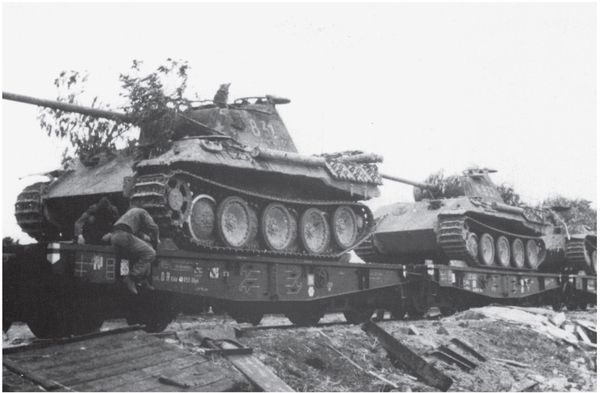
In response to these reports, Stalin ordered that a new battle plan for the central WisÅa area be worked up which would take account of the successes and reverses which had been experienced, as well as the “Warsaw fuss.” On August 8, Marshal Zjukov presented just such a plan to him. In his considered view, the most important objective for the 1st Ukrainian Front and the 1st Belorussian Front was to seize the two large bridge emplacements along the WisÅa. After which, seizure of similar emplacements along the Narew's banks should be carried out. Simultaneous with this, the central sector of Marshal Rokossovskij's front (the 8th Guards Tank Army, the 47th Army, the 70th Army, the 28th Army) should, without delay, begin attacking the enemy in Warsaw, with the exception of Praga, and this, together with an attack launched on the area around the join of the Bug and Narew Rivers (the 48th Army, the 65th Army) should lead to Heeresgruppe “Mitte” being split. Zjukov wrote, far too early, something about Soviet troops in the frontline units along the Wisla and the Narew achieving the preparedness necessary to carry out new attacks towards the west around August 25, 1944. On the other hand, he adopted a more sceptical view when it came to the possibilities of successfully carrying out further offensives in that direction, especially in light of the necessity for concentrating reserve troops as well as supplies for the large offensive planned for the Balkans which was shortly about to begin.
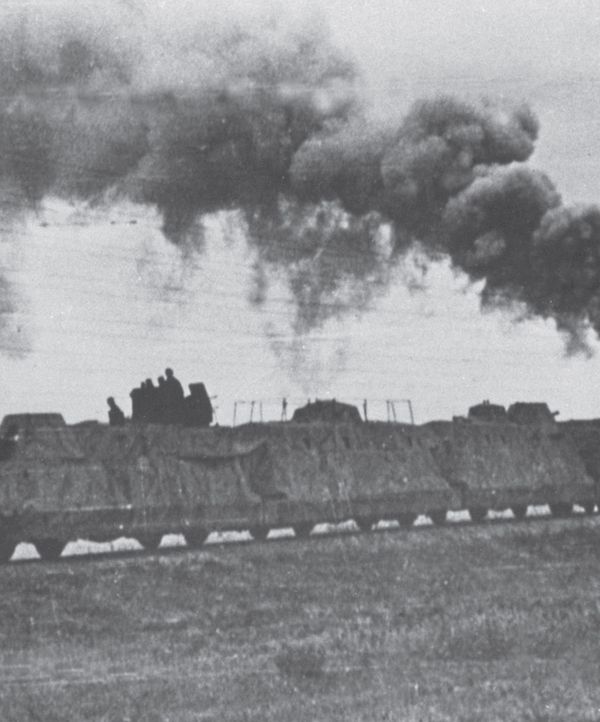
A German armoured train, model BP 42, the Warsaw Region, August 1944. (CAW)
On August 10, the fighting east of Warsaw flared up with renewed force. Marshal Rokossovskij set about destroying the German “balcony” in the frontline that stretched from StanisÅawów through WÄgrów all the way to Nur by the Bug River. This was not an easy mission, despite the Soviet side's numerical superiority. At the beginning of August, immediately after the tank battle was decided and done, the following forces were positioned along the section of the frontline referred to here: the 47th Army, certain units from the 2nd Tank Army (essentially, now only the 8th Guards Tank Corps), the 70th Army, the 28th Army, the 9th Tank Corps, the 2nd Guards Cavalry Corps, and the 4th Guards Cavalry Corps. Of these, the 47th Army's, 125th Rifle Corps stood directly outside Warsaw, and between Okuniew and the river Liwiec stood the rest of the 47th Army, the 70th Army, plus the 8th Guards Tank Corps and both cavalry corps, while the 28thArmy and the 9th Tank Corps were located to the east around SokoÅów Podlaski. Two days before the offensive was resumed, the 4th Guards Cavalry Corps from this formation was re-deployed and positioned on a passive section of the front by the WisÅa River between Karczew and Wilga.
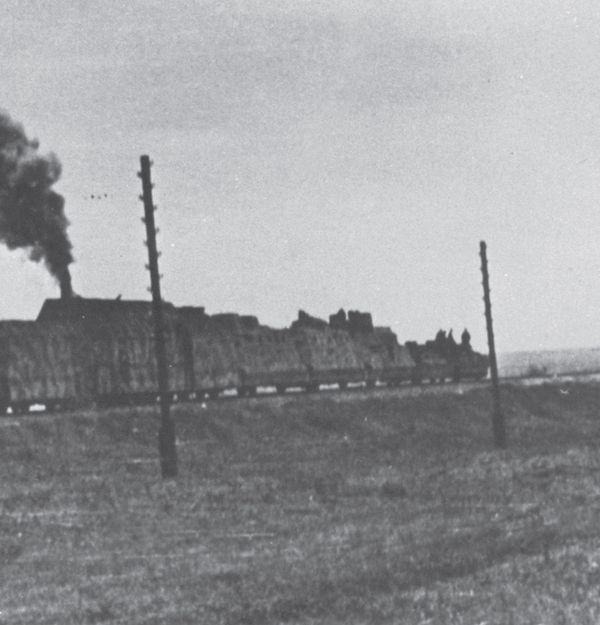
Initially, the Germans organized their defence with Gruppe “von Saucken” (the 3rd SS-Panzer-Division “Totenkop,” the 5th SS-Panzer-Division “Wiking”, the 4th Panzer-Division, the 73rd Infantry-Division, and the 1131st Grenadier-Brigade), the XX Army-Corps and the XXIII Army-Corps' right flank. With thought to the continuous Soviet pressure north of the Bug in mind, Generalfeldmarschall Model ordered, just before the enemy's next offensive commenced, that a portion of the forces defending Praga were to regroup in that direction (i.e. north of the Bug) which served to weaken the Warsaw based forces even more. On August 9, Gruppe “von Saucken” was broken up. General von Saucken, himself, together with the XXXIX Panzer-Corps HQ staff, was sent to the 3rd Panzer-Army which was defending western Lithuania and the border with East Prussia. With him, also disappeared the 4th Panzer-Division, as well as the 12th Panzer-Division from 2nd Army (re-deployed to the 4th Army). In Praga, there only remained the 73rd Infantry-Division and the 1131st Grenadier-Brigade â in short, a very modest force. On August 11, a new corps was formed as a replacement for von Saucken's unit. This was the IV SS-Panzer-Corps with SS-Gruppenführer Herbert Otto Gille, commander of the 5th SS-Panzer-Division “Wiking” appointed as the corps' commander. Initially, his former Division “Wiking” command was taken over by SS-Oberführer Eduard Deisenhofer and later by SS-Standartenführer Johannes Mühlenkamp who, in turn, was replaced on October 9 by SS-Standartenführer Karl Ullrich. As we now see, it wasn't until after the tank battle that the IV SS-Panzer-Corps was established. In addition to two Waffen-SS armoured divisions, its make up included the 73rd Infantry-Division and the 1131st Grenadier-Brigade.